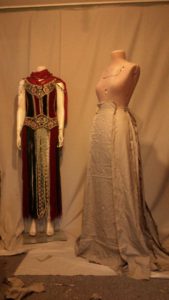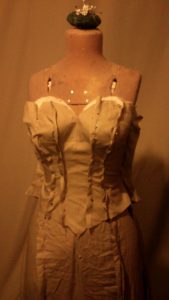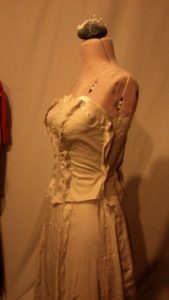Elsa pattern base!
Luckily I have had heaps of experience with both parts in terms of drafting and draping 🙂 Key things to note are:
Most commercial patterns are a good start, however they almost universally make backs too deep. It looks lovely on a dress form but on a human it winds up a secondary anchor point. There are two, generally speaking- at the waist and under the bust. These are where you can put circles of elastic and they will stay mostly in place. In the case of the former because there is rigid bone above and below (ribs and hips) and in the latter there is gravity/friction from breast tissue that also acts as a physical barrier.
Of course this is far from universal and speaking as someone who has one anchor point in actuality it still helps to work out where they both are for any support layers- hidden stay tape, where you can a padding etc.
So, the back; extend and widen. You can use inner stay elastic to hold the back in place and then let the bodice float over that, but this is the secret to victorian corsets- they rise higher in the back than the front. That is in part due to the rigid boning keeping the shape from displacing vertically. This eliminates the old bra line issue 🙂
Anyway, the bodice I draped here started as a rectangle of fabric and I put in extra padding on my form at the bust so that I can make the bodice to fit over that then padd the inside to shape. But I really need a foundation to at least start cutting my fabrics and find the most natural places to take in or let out as needed.
Oh and no, that is not yet the final shape. It’s close because I’ll do as everyone else has and ignore how the bodice actually sits right at the waist at the back and sides and only dips below at the front. Why? It’s not entirely flattering. Elsa does not have big hips and yet even she looks distinctly hourglass because the shape pulls over the hips making them more prominent.
I need to decide on accuracy over flattering so I will need to get started asap.
Oh and further to the above and to the previous post about shapewear- I did find one glorious bridal gown at Savemart. It’s the perfect example of how the inner of a high end gown is a very different shape to the outer. It was however a really good example of how bulky our modern formal wear is. I have an 1890s bodice that is fairly typical of the time and even with velvet it does not add much bulk. The stays (flat steels) are super thin, my steel boning is about 3X the thickness.
The corsets I have handled have likewise been much thinner yet as sturdy. Apparently it is in part down to our modern fabrics just not being as strong as in the past (which means we wind up using bulkier fabrics for the same strength). I do think there is a tendency to use bulky material to begin with. The fuzzy boning cover material is one example. It’s on underwire as well. You don’t need it.


